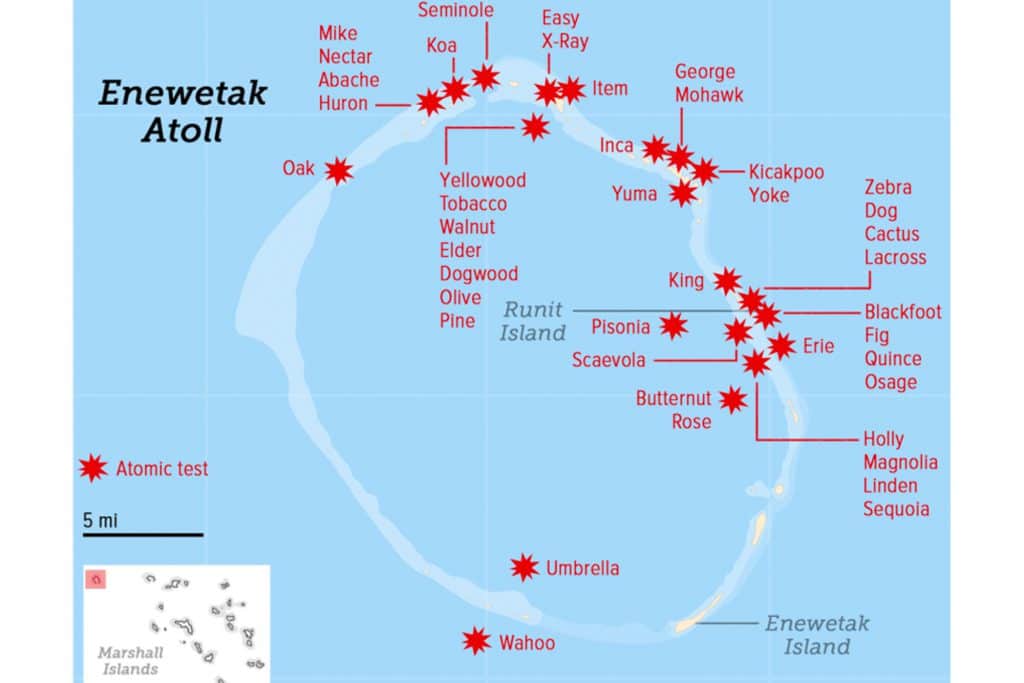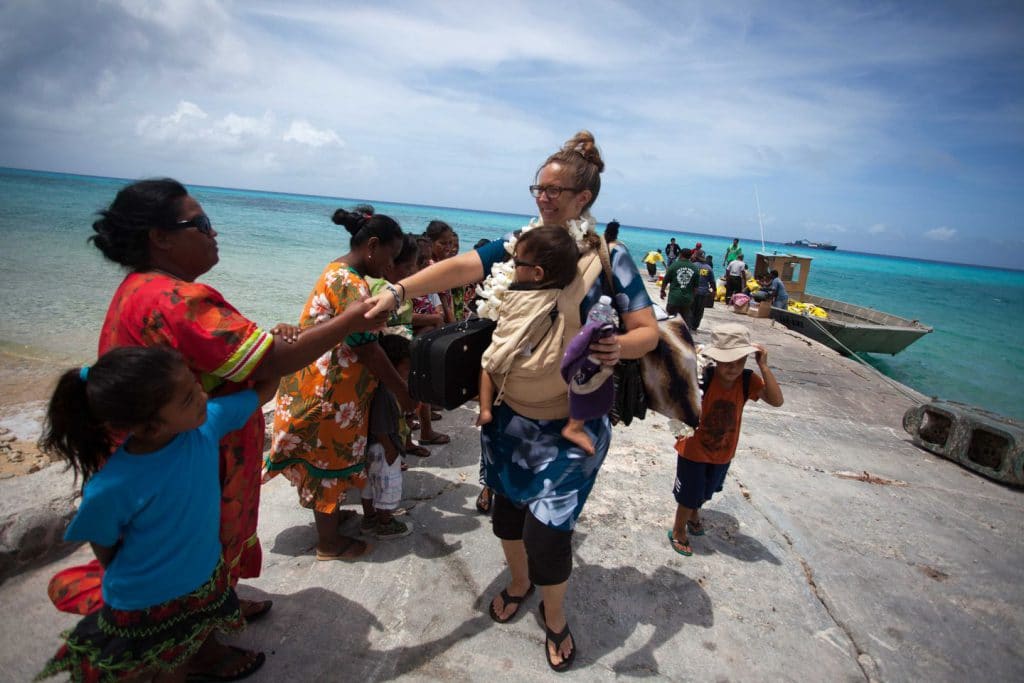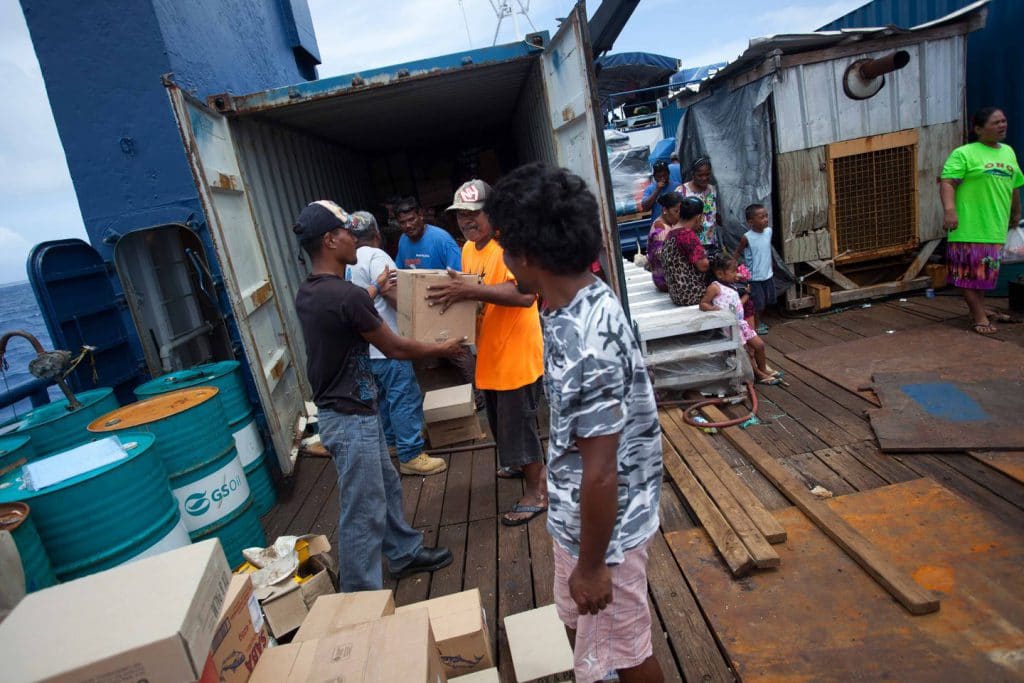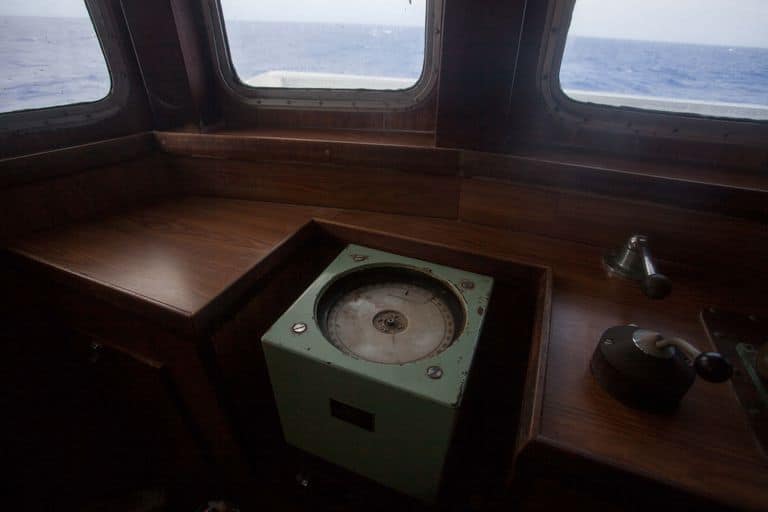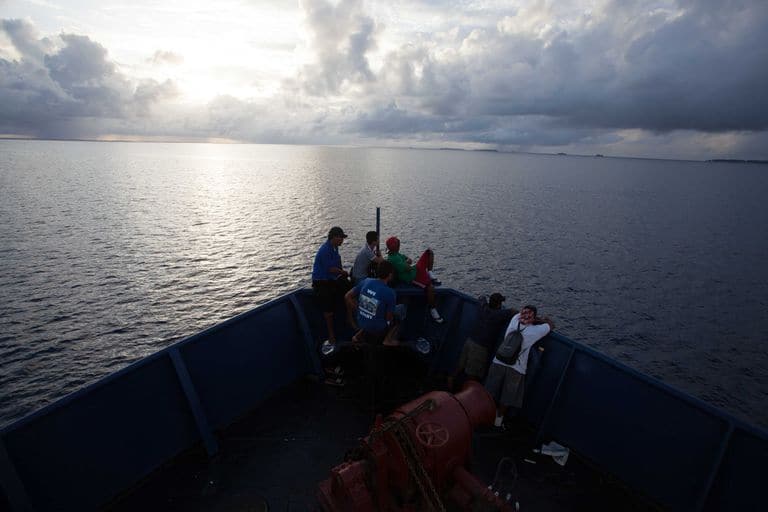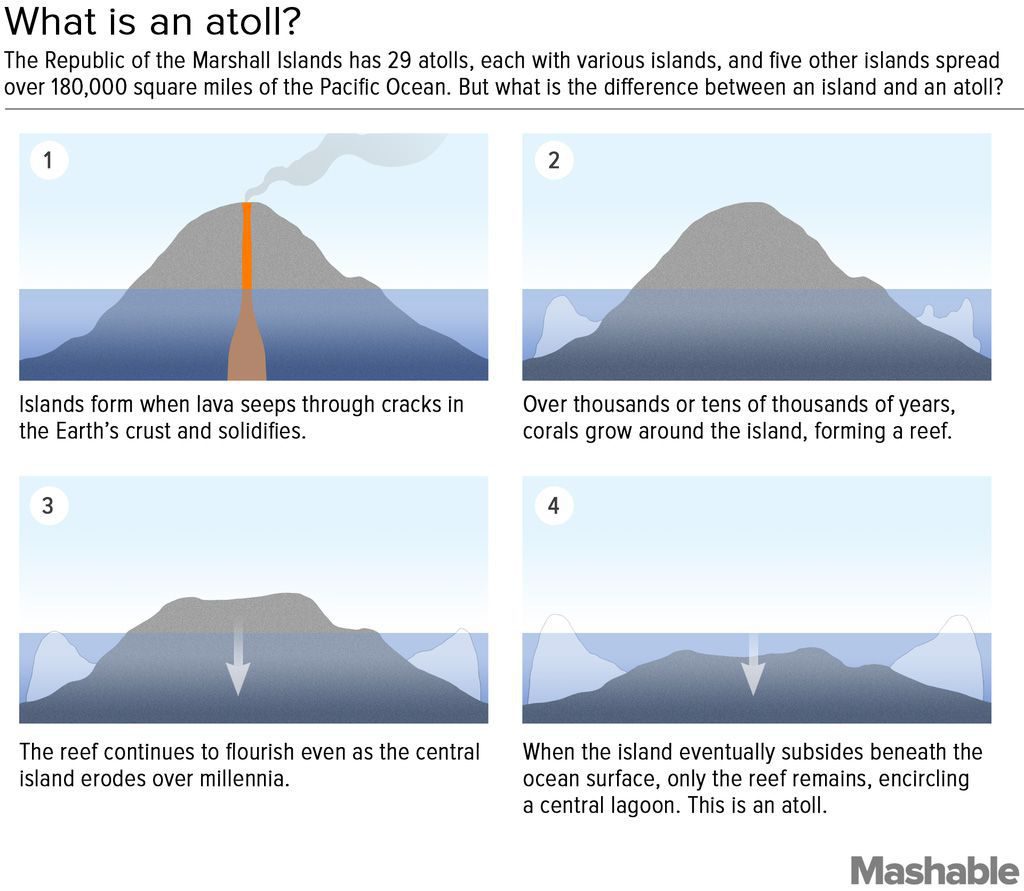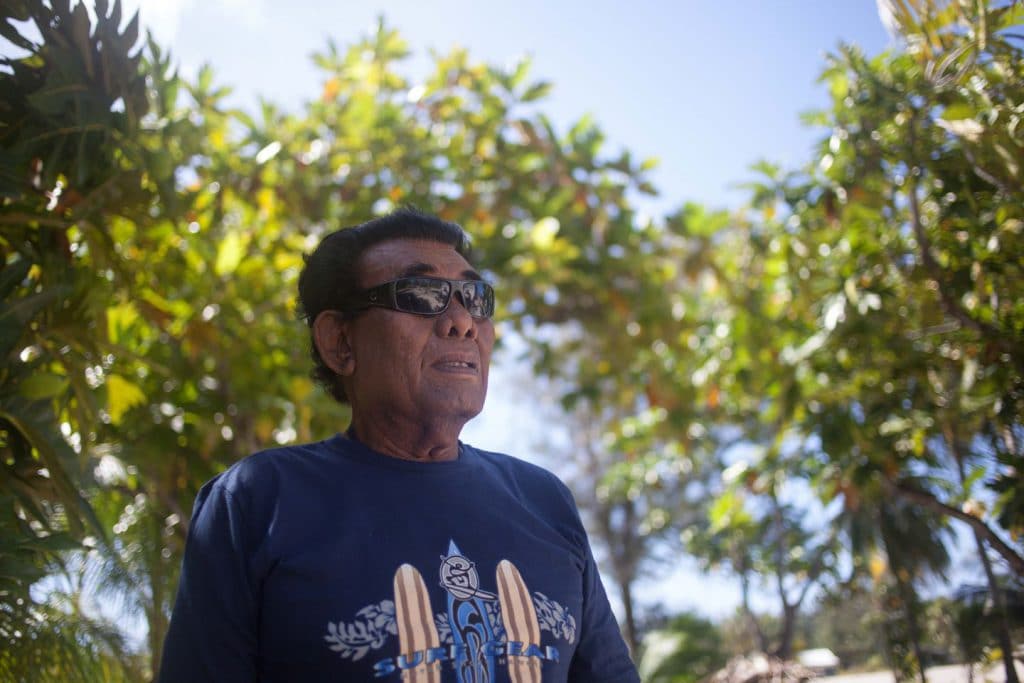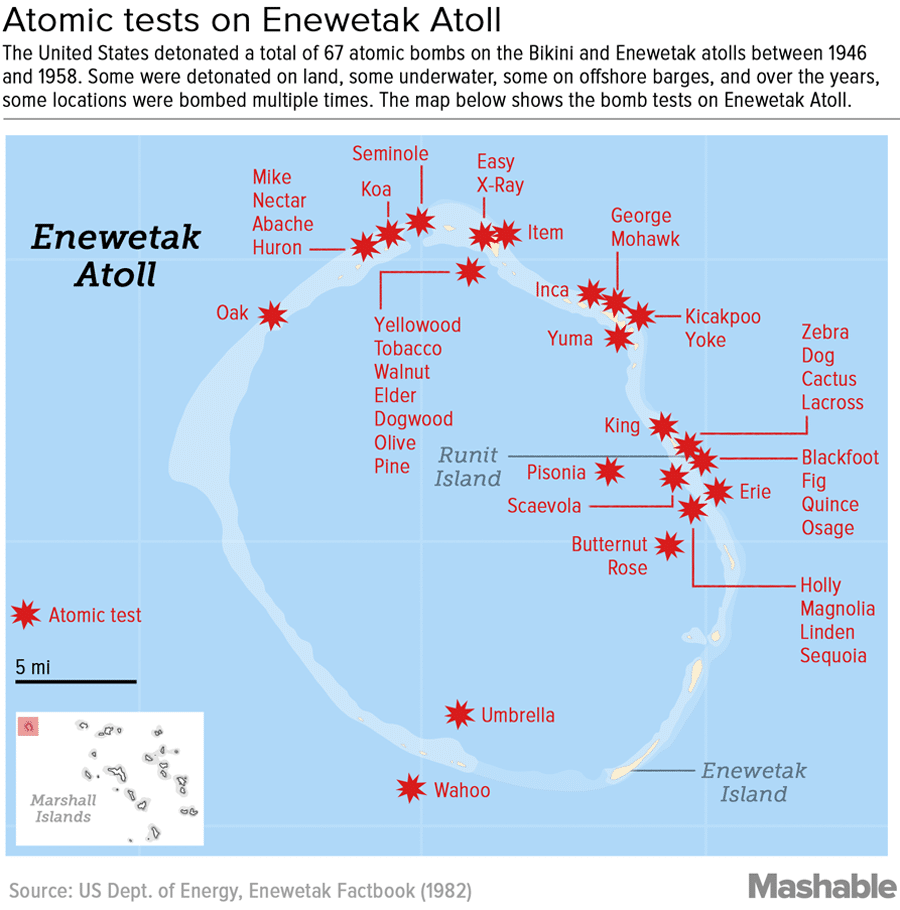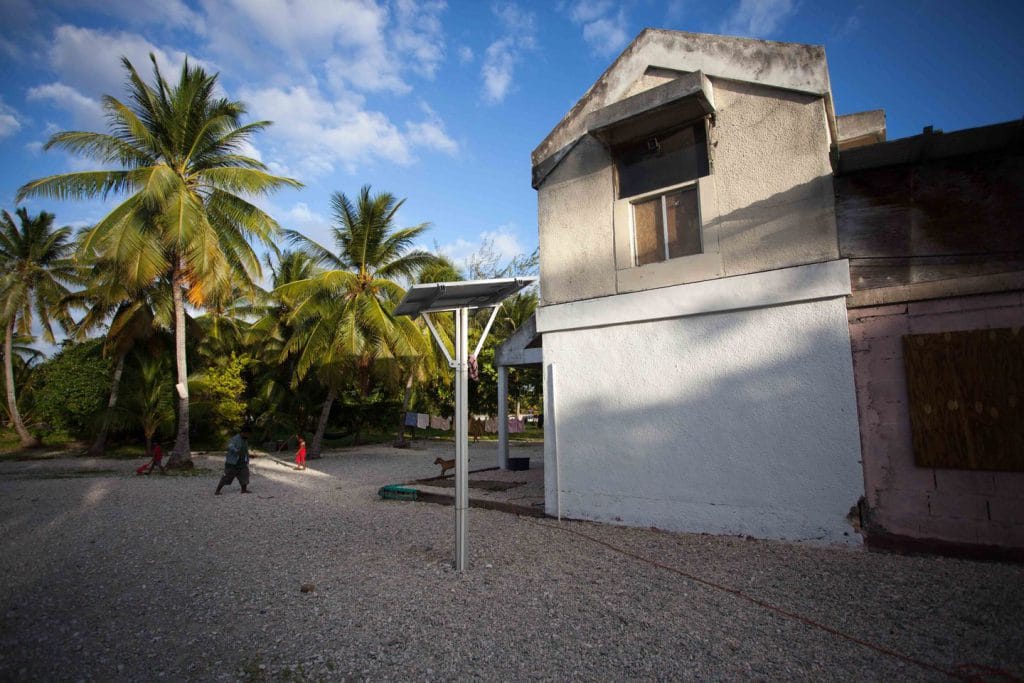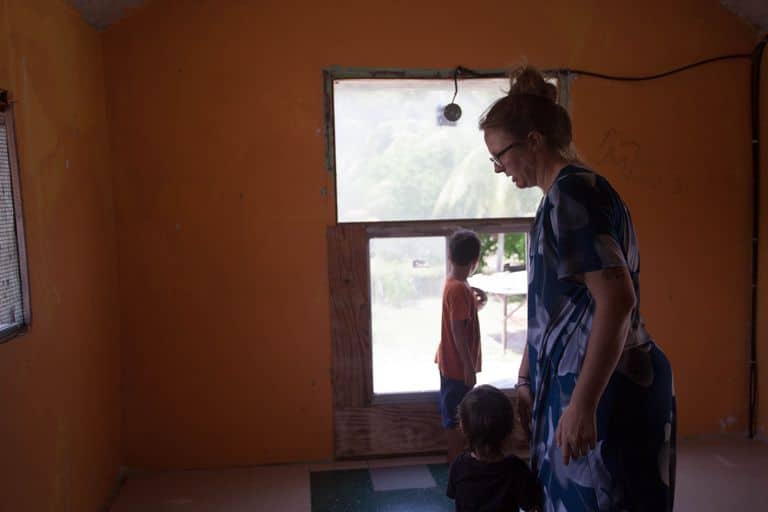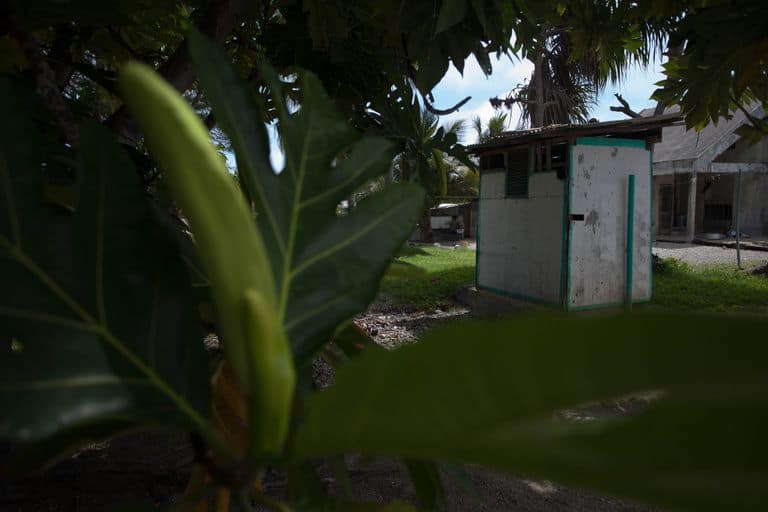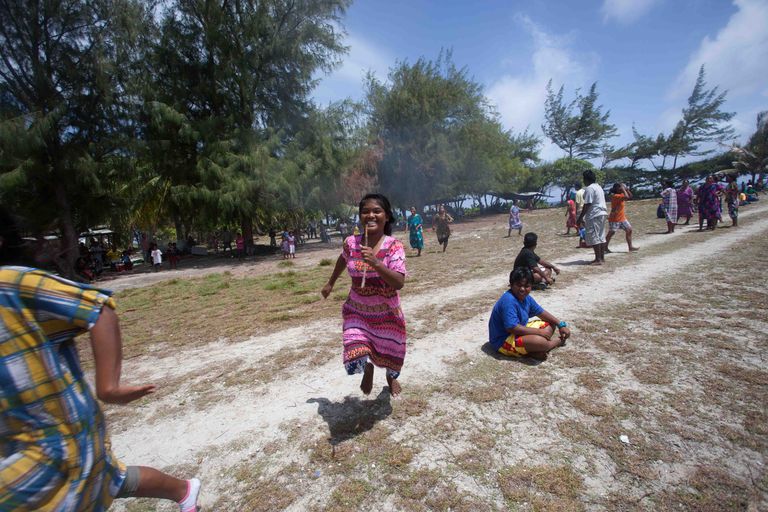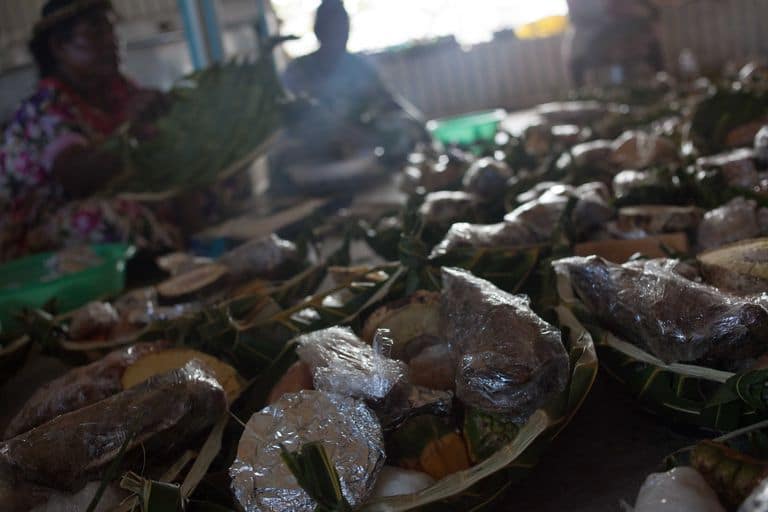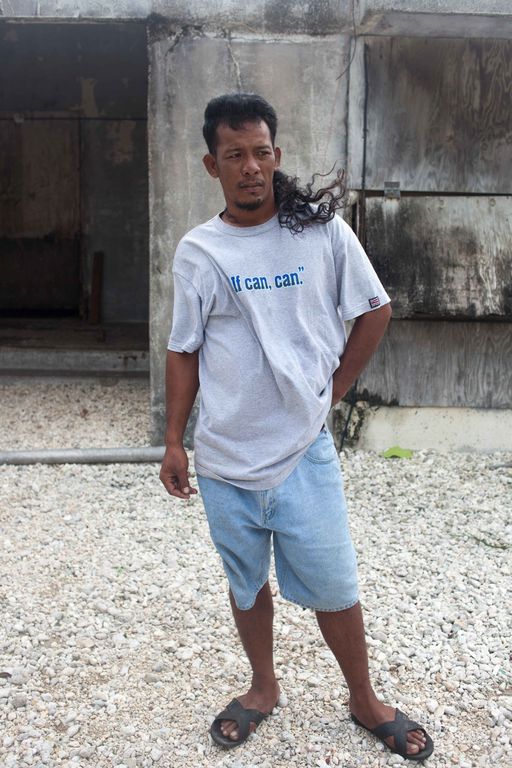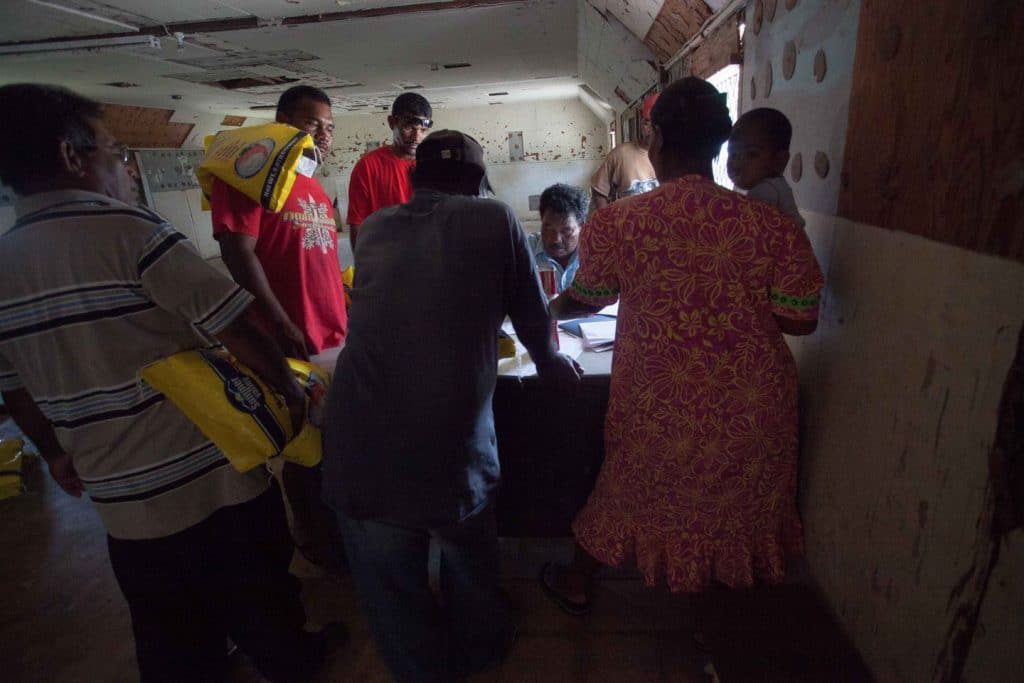Editor’s note: This is the first of a three-part multimedia project that spotlights the daily lives of Marshall Islands residents. Kim Wall, Coleen Jose, and Jan Hendrik Hinzel reported from the Marshall Islands and Arkansas in 2014 and 2015.
Ages, figures, and situations related to each character are tied to the on-the-ground reporting. However, some general information has been updated with dates noted in the text where necessary. Wall worked on this series until her untimely death on August 11, 2017.
It takes three days on the open sea to journey from the Marshall Islands capital to Enewetak Atoll. You can’t see the atoll until you’re just miles away as it’s only feet above sea level. As you get closer, the sun fades behind clouds and the islands are shrouded in mist. Beaches are fringed not by coconut palms but Australian pines, trees praised for soaking up salt-spray and airborne radionuclides.
One of the two atolls handpicked for U.S. nuclear testing after World War II, Enewetak, was never famous enough to have a swimsuit named after it, like better-known Bikini. But the atoll consisting of 40 islands saw almost twice as many atomic tests. It’s the most remote atoll within the Marshall Islands, with Guam thousands of miles to the west and Japan thousands of miles to the north.
It isn’t a place where most mothers would take their children. Brooke Takala-Abraham knows that. But with her husband Mores, sons Ahti and Aapo, niece Milan, two kittens, three dogs, a pickup truck, a Geiger counter, and food supplies to last a few months, she disembarks from a boat that’s also bringing provisions for about 600 people from Majuro, the Marshall Islands capital, to Enewetak’s main island.
Between 1946 and 1958, the U.S. nuked the Marshall Islands 67 times: The effects could be compared to dropping 1.6 Hiroshima bombs every day for 12 years. When the tests ended in 1958, forced displacement and radiation poisoning had already changed the nation irrevocably. The Marshallese had no words then for the horrors that would result, like poison and cancer. Now, they face a new problem: the Armageddon of rising sea levels due to climate change. Yet another deluge of scientific terms washes over the islanders –some simply call it the “changing clouds.”
Mores descends from a line of Enewetak chiefs. Although the Marshall Islands is a democratic republic, a complex tribal system assigning land rights to clans and families still plays a significant role in everyday life. But Brooke and Mores are no ordinary royal family.
Much of the kingdom their children will inherit is laced with radioactive plutonium, one of the most toxic substances known to man, with a half life of 24,100 years. In Enewetak, people simply call it “the poison.”
Pushed together, the landmass of the Marshall Islands’ 29 atolls and five islands would equal Rhode Island’s. With such extreme scarcity of land, it is perhaps not surprising that just about everything in the Marshall Islands — currency, identity, and social hierarchy — revolves around it.
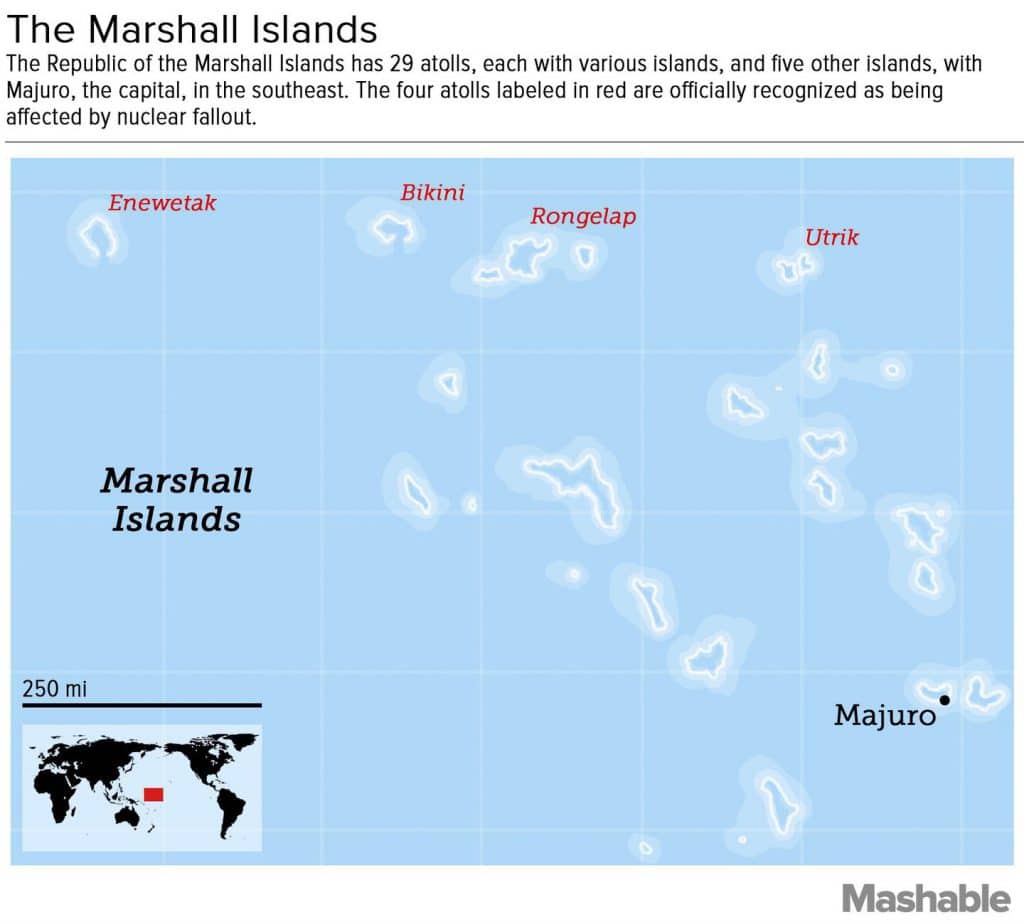 Brooke and Mores met in Enewetak eight years ago. She, an American from Montana with Finnish heritage, was a teacher, contracted by the local government. Romance was the last thing on her mind. He was an island-chief-to-be with bad-boy appeal who smoked and drove a motorcycle up and down the airport runway. As chance would have it, both their mothers had fallen victim to radiogenic cancers and U.S. radiation experiments.
Brooke and Mores met in Enewetak eight years ago. She, an American from Montana with Finnish heritage, was a teacher, contracted by the local government. Romance was the last thing on her mind. He was an island-chief-to-be with bad-boy appeal who smoked and drove a motorcycle up and down the airport runway. As chance would have it, both their mothers had fallen victim to radiogenic cancers and U.S. radiation experiments.
Soon, Brooke was pregnant with Ahti. Then Aapo. They left the atoll for Majuro, which is overcrowded and battling erosion, with a brief stay in the U.S. The boys, two and six years old, got American-Marshallese citizenship and Finnish names.
Brooke, a dirty-blonde ribelli, the Marshallese word for stranger, taller even than the men, carries a violin and a toddler as she disembarks. Her outfit blends right in: a flower-patterned guam dress, just like the island women wear. Enewetak’s mayor, with the island’s uniformed police force, spearheads a welcome party with chilled coconuts and keyboard calypso. The crowd around her is vast — it’s March, and there hasn’t been a ship since Christmas — but the warm welcome isn’t just hospitality. Enewetak has starved for weeks.
Welcome to the world’s forgotten nuclear ground zero. One where sea levels are rising, inundation from typhoons is worsening, and weather patterns are shifting to favor prolonged drought.
NUCLEAR NOMADS
The boat that brought Brooke and her family, the Lady E, took what seemed like forever to leave Majuro. Amid reports that Enewetak’s residents had run out of food, the government-owned supply ship kept breaking down, one compressor and missing spare part at a time.
In Majuro, where Brooke’s family lived for five and a half years, people from Enewetak don’t have land rights. They live on land borrowed from the local tribe or they rent. As a result, some of them give up on the traditional tribal system altogether and move to Hawaii. And then there are people like Mores, who desperately wants to be back home on his own land.
“We’re just taking a leap of faith and trying to do what we think is best,” says Brooke, nauseous and drowsy from seasickness pills. “Of course I have fears about bringing my young children to a place that may not be suitable. Am I putting them in harm’s way? Most likely, but I also think that that harm is already inside both my husband and me.”
On Enewetak, she’ll research the atoll’s traditional ways of passing on knowledge — what’s left of it, 43 nuclear bombs later — for her doctorate degree in sustainable education at the University of the South Pacific. An activist at heart, she has visions of addressing the United Nations about the injustices committed here.
“I think the world has forgotten what has happened there,” Brooke explains, tears in her eyes. “They forget that there’s a whole community of people living next to the world’s largest nuclear waste site.”
“Of course, I’m scared of radiation, but it’s a tradeoff,” Brooke had said a few days earlier, seated in a waiting room of the U.S. Department of Energy’s (DOE) lab in Majuro, studying the charts and graphs of radionuclide levels in populations across the nation. “We need to go back to bring the world’s attention to Enewetak and to the rest of the Marshall Islands.”
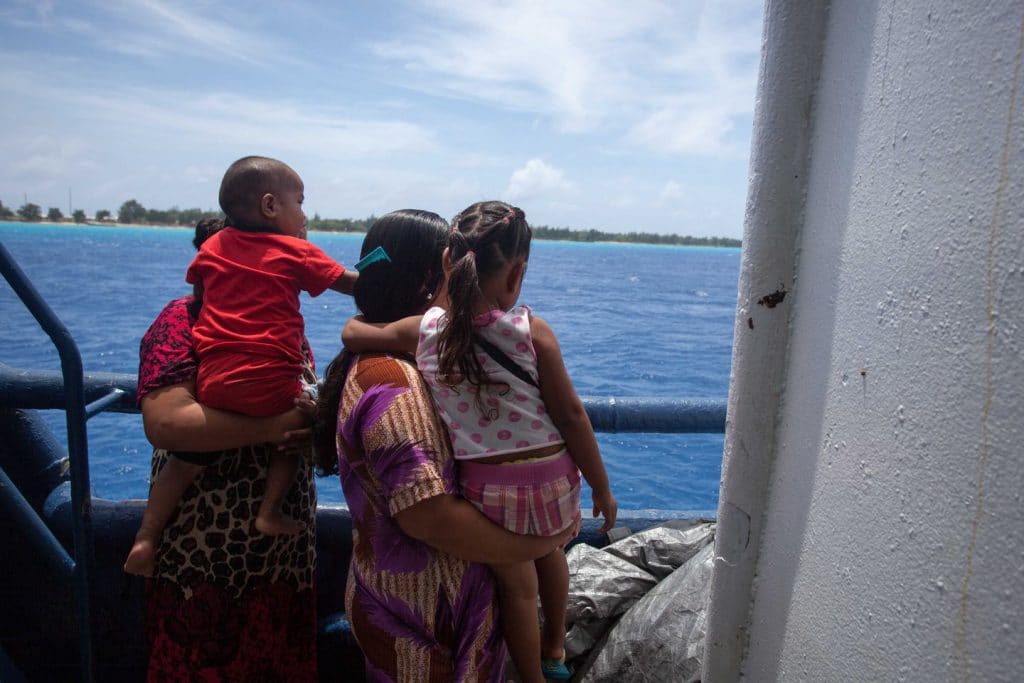
Passengers aboard the Lady E look out onto the ocean. It’s three days of travel on the open sea from Majuro to Enewetak.
Aboard the Lady E, a dozen passengers are dispersed on hand-woven tatami mats around Brooke; some don’t move for days. The waves rock the ship relentlessly for days with no land in sight. The Marshallese, once great seafarers, hold on tight to the railings as they vomit overboard.
There is a Marshallese notion for it, Brooke explains: pelok. To be lost at sea, drifting away to die — literally and figuratively. She doesn’t want that for her children. She doesn’t want them to grow up without the ancestral land that’s tied to their identity, their lamoran as it’s known on the Marshall Islands. That’s why they have to go back.
WHAT HAPPENED TO ENEWETAK?
Enewetak Atoll was just what the Americans had been looking for in a nuclear testing site: sparsely populated, equipped with a gigantic Japanese-built airstrip, and sufficiently far from major shipping lanes while still close enough for supplies from Hawaii.
While bombing Bikini, VIPs, American politicians, and the media treated the tests like a Hollywood spectacle. Seen as a small price to win the Cold War, Americans celebrated it as a manifestation of the nation’s greatness: Cakes were baked in the shape of mushroom clouds, Miss Atomic beauty contests were held, and a new scandalous bathing suit was named after a nuclear testing site. In Enewetak, the Americans didn’t bother asking for permission.
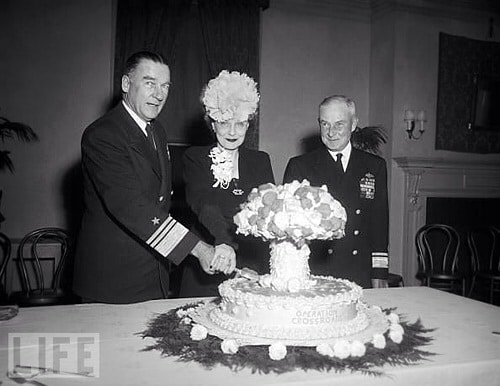
U.S. Navy Vice Admiral William H. P. Blandy, his wife, and Rear Admiral Frank J. Lowry cut a mushroom-cloud cake in Washington, D.C., November 6, 1946.
STOCK MONTAGE/GETTY IMAGES
“The elders had no power, and the Americans told them: ‘You guys are moving … to Ujelang,’” Takaji Iso, one of the few eyewitnesses still alive recalls. “The elders said ‘no,’ but the Americans said ‘go.’”
Takaji, 78, remembers spending weeks on the Pacific. A boy at the time, he was in awe of the sheer size of the ship: a U.S. military vessel, complete with volleyball courts on deck. As atomic bombs fell on Takaji’s ancestral land, shockwaves rocked the ship like a toy boat.
“We saw the explosion go high, and the brightness shone like blood,” he recalls six decades later. “It was like blood in the sky.”
Ujelang, the atoll Takaji and 145 other islanders had been displaced to, wasn’t theirs, nor was it among the four atolls the U.S. officially recognized as affected by nuclear testing.
Even compared to Enewetak, Ujelang Atoll was isolated. One-fourteenth the size of the islanders’ homeland, arid, typhoon-battered, with a lagoon that never seemed to have enough fish, Ujelang was perhaps uninhabited for a reason. The evacuees arrived to a U.S.-built village with water catchments, houses, a council hall, a school, a church, and no means to contact the outside world.
With the exception of occasional visits by supply ships every four to eight months, the islanders were left to fend for themselves.
Over the decades, the self-reliant lifestyle of the Marshallese fell apart; ancient knowledge was forgotten.
Hungry, ignored, and homesick, the Enewetak islanders in Ujelang grew impatient. In the early 1970s, they — Takaji among them — boarded a government supply ship and staged a sit-in: “You take us back to Enewetak or we’re not getting off the boat,” they demanded. Others protested on the beach: Returning to a contaminated homeland was better than starvation in exile.
The Americans eventually gave in. The strategic value of Enewetak’s islands had already diminished anyway. A $100-million repatriation plan was initiated and, between 1978 and 1980, thousands of American servicemen were dispatched to make the atoll fit for human settlement again, bulldozing hundreds of thousands of cubic yards of radioactive soil.
“I was surprised when I came back to Enewetak,” said Takaji, seated outside the two-floor, typhoon-resistant concrete house that American and local contractors built for him on Enewetak’s main island. “There were no coconuts, no trees, nothing … ”
After 33 years in exile, the island he returned to looked nothing like the one he left.
THE TOMB
Runit Dome is a nuclear waste site that hasn’t had a warning sign on it for years. Like a spaceship crashed on Enewetak’s shores, it’s strangely ominous. Parasitic vines creep over it, black seabirds nest in its cracking concrete. Its summit is only 25 feet above sea level, marked by a cryptic inscription: “1979.” The tide forms a moat around it, full of algae. The water is calm, like a mirror reflecting the azure skies above. A few feet away, waves lick at a crumbled sea wall. There are no crabs on the white beaches, though rats — one of Enewetak’s four land mammals (along with domestic dogs, cats, and pigs) — dart between shrubs.
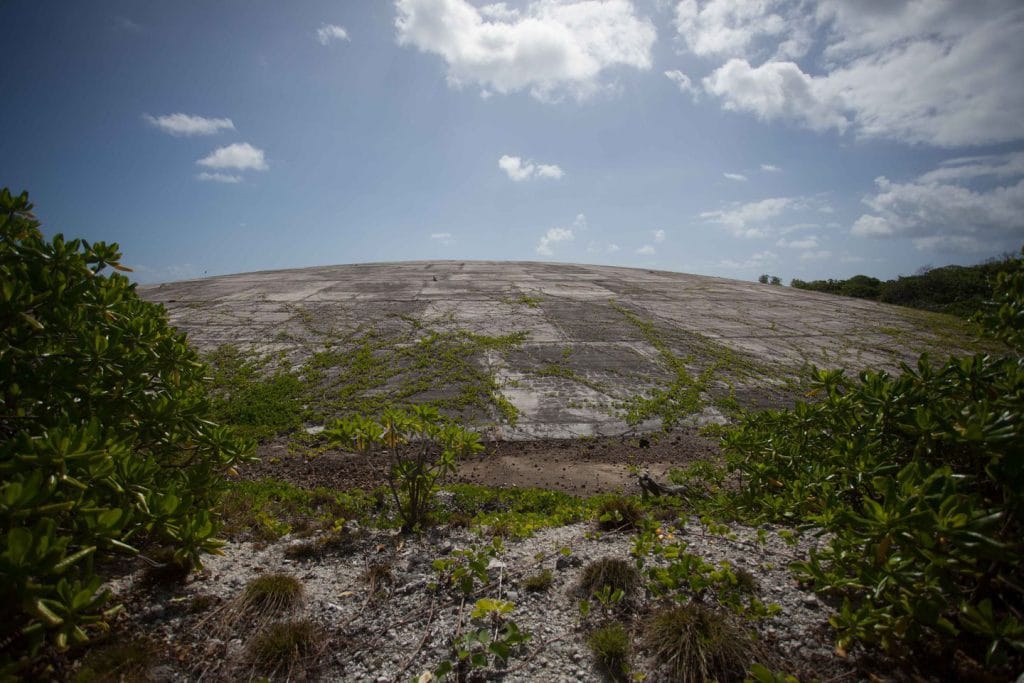
Runit Dome is where Americans buried contaminated soil after the bombings. The concrete is expected to break in the future and due to rising sea levels, it could one day be under water.
The Americans knew the dome by its code name: “Yvonne.” Out of 43 bomb tests in Enewetak, they detonated 14 hydrogen bombs — all with cute noms de guerre like “Cactus,” “Fig,” “Rose,” and “Butternut” — here on Runit, an island in the atoll that’s long, thin, and vaguely shaped like a seahorse. Forts overgrown with shrubs dot the shorelines, the surge crashes over colorful copper cables sticking out of the sand. Rusted metal cords are still piled in the jungle, and bright green copper shards adorn the ground like confetti. Runit Dome rises ominously over the southern tip of the island.
Locals call it the tomb.
Perhaps an initial mishearing of the word dome, the name is fitting. The dome, sealed by 18 inches of cement, is a grave for ancient traditions irrevocably destroyed, mixed in a slurry of radioactive debris and soil contaminated by the fallout from hydrogen bombs detonated all over the Enewetak Atoll. American servicemen and contractors built it on fractured coral rock in the crater of one of the detonations and filled it with contaminated soil as they cleaned up the islands.
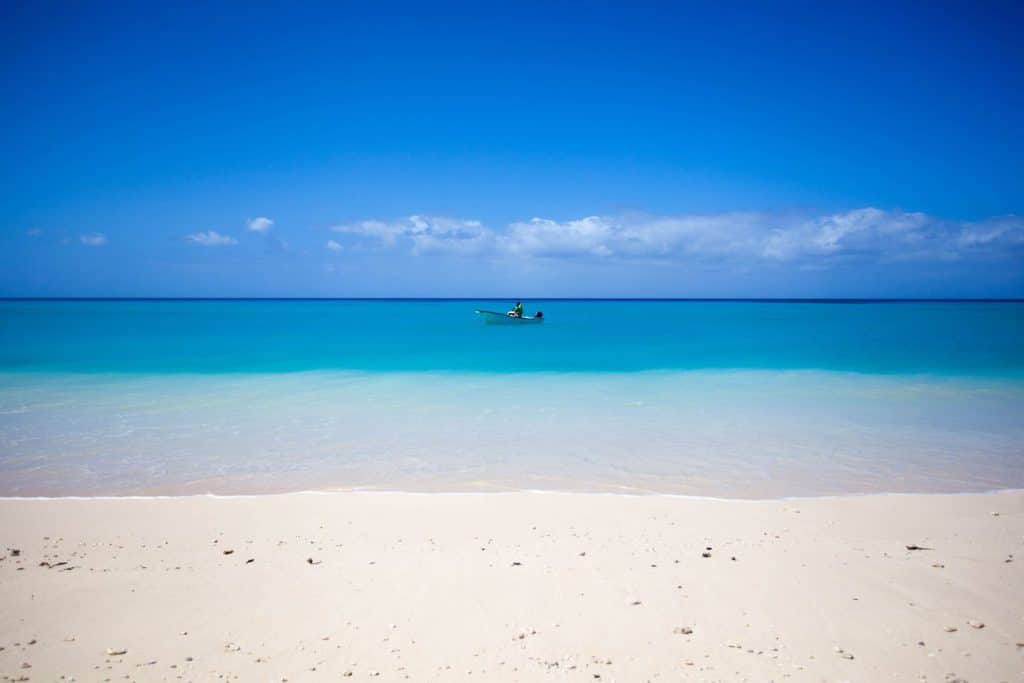
A boat approaches Runit Island in Enewetak Atoll. The island is home to a leaking nuclear waste site.
Runit is about 15 miles from Enewetak’s main island. It took Takaji and Brooke about an hour to get here from Enewetak. Takaji is one of a handful of elders who witnessed the bomb tests in Enewetak and on this day, Brooke came with him to Runit to learn more about the dome. It’s the first time she’s set foot on Runit. In a small boat, they crossed the atoll’s vast lagoon, bypassing reefs and other islands that break the Pacific’s massive waves. As they arrive, there is no fence to keep visitors away, even though the nuclear waste site doesn’t meet the safety standards of a U.S. garbage dump.
Calmly, with tears running down her cheeks, Brooke walks around the site in sandals. She rejected the protective face masks worn by the boat’s crew. “I already have the poison in me, what would it help?” She’s taken aback by the island’s beauty and devastated by its lost possibilities.
“If they knew enough not to detonate these bombs in outer space or on seabed, why would they detonate them anywhere else?” she asks, angry now. “It’s very hard for me to understand how my lamoran, the United States, my country that I love, could feel that way about other people.”
As money ran dry, the clean-up efforts came to an end prematurely — only three out of 40 islands were deemed safe for human resettlement. Enjebi, another island in the north of the atoll and one of Enewetak’s former population clusters, was left half-finished, though its heirs were offered the chance to return anyway, with restrictions: eat only one coconut a day, elevate cookhouses to at least two to three feet above ground, constantly wear rubber boots. Resettlement plans were indefinitely stalled when the islanders refused. Though Aati and Aapo are the rightful heirs to the land, Brooke doesn’t dare take them there.
The plutonium isotopes (Pu-239) that contaminate the atoll have a half-life of 24,100 years. This is another contrast to the so-called Pacific Proving Grounds’ two test-sites: Whereas Bikini’s radioactive contamination consisting mainly of Cesium (Cs-137) will have decayed within a generation, Enewetak’s plutonium will be hot for much, much longer.
Yet the dome wasn’t built to last; it was intended only as a temporary solution.
It’s a matter of when — not if— it will crack open. Rising sea levels may submerge the waste site within generations, and a typhoon could rupture it even earlier, according to a study commissioned by the DOE. Thirty-six years on, no one has come up with an alternative.
Already, the Dome is leaking.
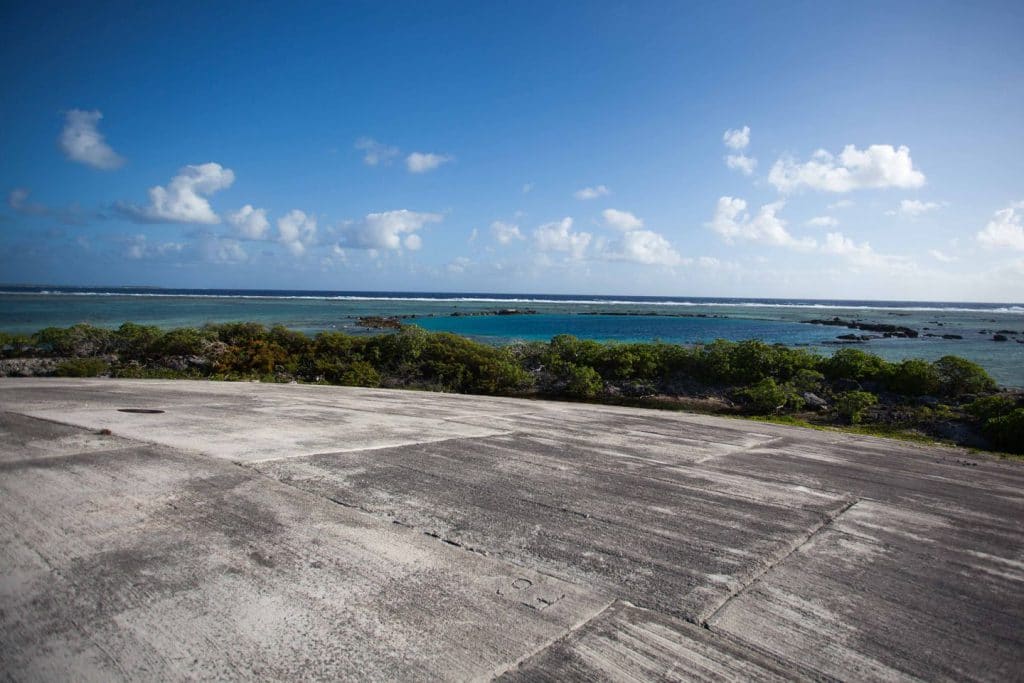
“Runit Dome represents a tragic confluence of nuclear testing and climate change,” said Michael Gerrard, director of the Sabin Center for Climate Change Law at Columbia University.
In 2013, Terry Hamilton, the scientist contracted by the DOE via Lawrence Livermore National Laboratory in California, published a Runit report that evaluates the integrity of the 358 cement panels that make up the dome’s cover. The report confirmed that radionuclides seep outside of the dome via the groundwater. Yet, Hamilton says, this doesn’t matter — the lagoon’s sediment is already more contaminated than what’s inside the dome.
The report was never translated into Marshallese or distributed to the local population. In a country where many people already feel like they have been treated as America’s guinea pigs, this contributes to further mistrust of the DOE.
Another scientist, Ken Buesseler, of the Massachusetts-based Woods Hole Oceanographic Institution, whose team studied the area in 2013, confirmed that the area around the dome is highly contaminated. “They didn’t get everything in the dome,” Buesseler said.
U.S. government reports and anecdotes from clean-up workers confirm that vast amounts of irradiated debris and soil were dumped and bulldozed into the lagoon directly: some of it concrete sealed, some not.
According to Buesseler’s findings, the area around Runit is the source of half of all plutonium contamination in Enewetak. Other high dosages are near various points where bombs detonated. Most of the lagoon’s seafloor is contaminated. Enewetak is the main source of plutonium in all of the Pacific.
Buesseler and his team collected sediment samples from 60 to 80 centimeters below the seafloor. But he suspects the contamination reaches even deeper. “Usually, you’d see contamination in the top 10 centimeters. Here you have no end in sight.”
Runit used to be the richest fishing ground, Takaji explains to Brooke, giving a guided tour of his lamoran. The DOE insists fish and seafood here would meet international guidelines and has never imposed restrictions. Some still fish here. Takaji remembers when boats had to take a mile detour around Runit. Nowadays, no one cares. People just go.
He’s thinking about leaving forever — maybe for Hawaii. “Runit is where my grandparents are from. What can I say? The Americans have already ruined it.”
Though Runit contains a multitude of deadly radioactive isotopes, Brooke’s Geiger counter, a gift from a friend, stays silent as she brushes it over plants and rocks. The alpha-radiation of plutonium — Enewetak’s biggest problem — is best monitored via soil or urine samples.
Plutonium (Pu-239) is not a very mobile radionuclide, it mainly clings to sediments and likely doesn’t end up in Enewetak’s drinking water or wells. It’s also not as likely to end up in the food chain as cesium. Instead, Pu-239 enters the human body primarily through inhalation of irradiated dust, where it is stored in the lungs, liver, and skeleton for a lifetime of wreaking havoc.
The crystal clear water and pristine beaches might be able to hide their poisonous secret. But not the dome. For Brooke, it represents the evil that was done here. As the tiny boat with Brooke and Takaji speeds back to the atoll’s main island, the lagoon’s vastness creates an illusion of deep sea with no way of knowing where the Pacific ends and the sky begins. Behind Runit’s forgotten forts and bunkers, the sun sets in a blood-red sky. It’s pitch black before Brooke reaches Enewetak’s solar-powered shores: a beacon of human presence in the midst of toxic islands. Over its abandoned airstrip, the Milky Way lights the starry sky.
DAILY LIFE ON ENEWETAK
Today Enewetak has exactly one car, five pickup trucks, one bus, one water truck, and 100 almost identical weathered, two-story concrete houses. The Takala-Abrahams brought baby-blue paint to personalize theirs. It’s dusty and cobwebbed after five and a half years away. The roof is leaking and the car and water catchments are mysteriously gone.
Stubbornly, Brooke turns it into a home, while settling into outer island time — no one wears a watch here — and her role as a chief’s wife. Without electricity and modern appliances, she gets creative with limited supplies: adding sriracha or spices from overseas, storing meat and chicken in the island’s only freezer room for special occasions.
“This is where I was born and raised,” Mores, Brooke’s husband, explains. “I didn’t wanna go away from here. You know, when I was in Majuro, I just waited to go back to Enewetak. Now I’m back here, it’s gonna be hard — but I’m happy.”
Four decades of nuclear colonialism have left macabre landmarks on Enewetak’s shorelines: gargantuan, corroded cylinders; an empty, Olympic-sized swimming pool; and a desolate 8,000-foot airstrip that can fit B29 bombers and jumbo jets. The national airline, Air Marshall, hasn’t scheduled flights here in years, but a sign on its abandoned terminal pavilion still welcomes visitors.
Nowadays, the main connections to the outside world are the island’s only landline ($5 for 10 minutes) and a too-slow-to-function router turned Wi-Fi hotspot.
Still, Ahti and Aapo live the idyllic island dream Brooke envisioned: playing outside from dawn to dusk, swimming in the lagoon, bringing new animals home almost daily. Brooke struggles to say no, and the menagerie grows exponentially: a chubby puppy, two more squeaky kittens, a rooster (rescued from the jaws of the dogs). A lizard, its ancestors imported by the Japanese to kill rats, sleeps in the kitten cage.
European Union-funded solar panels power their flat-screen TV as neighborhood children sprawl out on mattresses to watch cartoons amid mosquito incense. Milan, Brooke’s niece, returns to her biological mother, who lives a stone’s throw away, on the other side of the runway.
When a typhoon ravages the islands, its wartime past washes up on its shores: U.S.-branded gas masks, a Japanese helmet, glass Coca-Cola bottles, melted lead. As climate change ravages Enewetak, will more frequent and severe storms stir up what’s in the lagoon’s open craters? The countless barges and shells? Brooke wonders aloud what else will wash up on her doorstep.
Days blend together. Neighbors throw their baby’s first birthday party — a keemem, an island speciality — serving everyone gigantic palm-leaf baskets of cake, whole reef fish, pork, mashed potatoes, and a loaf of bread. The baby, big-eyed and dressed in sequins, sits on the floor as a whirlwind of well-meaning adults put single dollar bills in front of her. High on live keyboard music and cans of sugary Hawaiian fruit punches, the guests dance all night.
Only 15 miles away, out of sight and out of mind, is Runit’s ticking atomic time bomb.
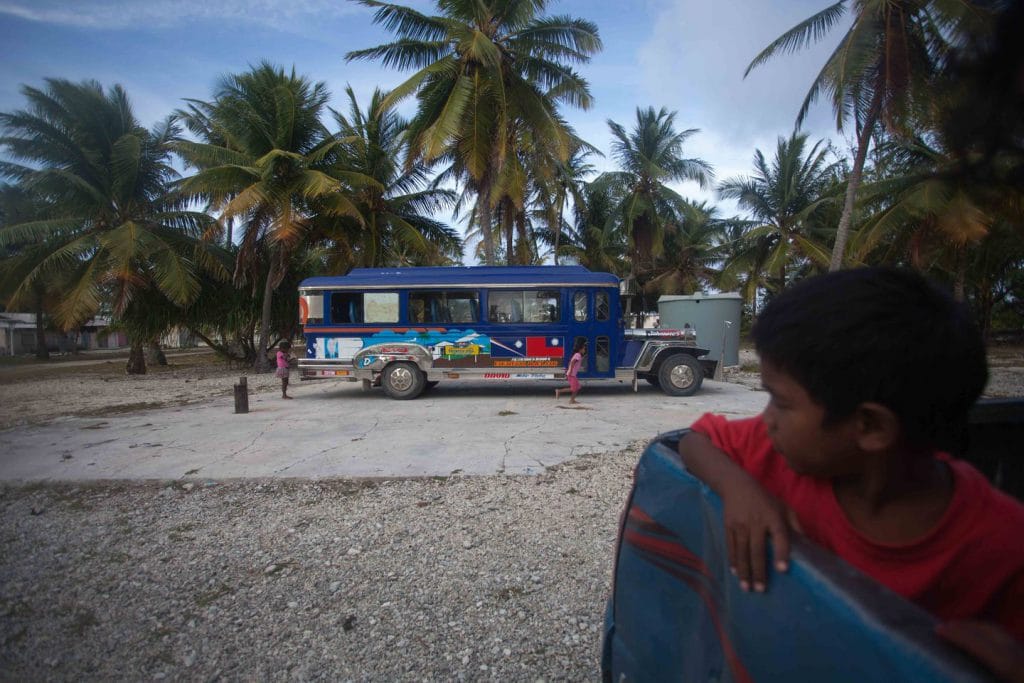
A boy looks at a “jeepney” in Enewetak. The vehicle is among the few modes of transport on the island’s single road.
THE COPPER DIGGERS
Because Enewetak’s coconuts and fish are barred from export, there aren’t many ways to make money. But the locals have found another good they can trade.
They ransack Enewetak’s islands, especially Runit, for copper left over from military installations of the nuclear testing era. Ashes mark where Enewetakese have dug up copper wires and burnt off their rubber coating. They then sell the copper to a guy on the main island who has no idea what it’s used for but ships it further on to China.
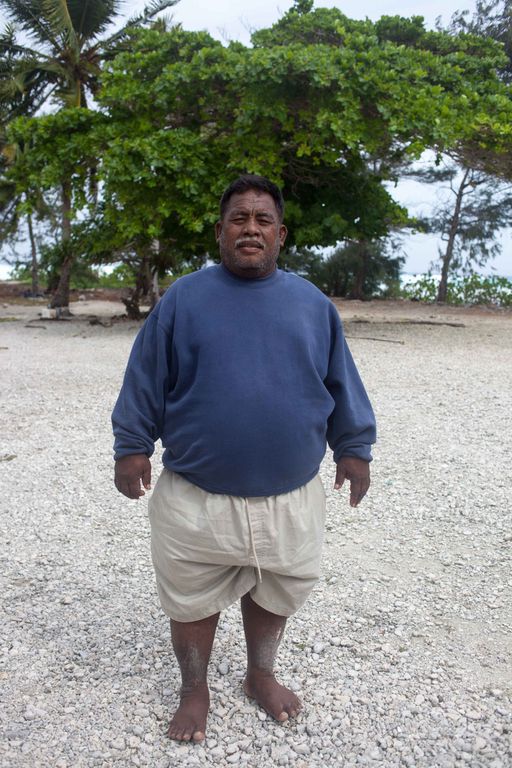
Tonis Luther, a policeman, sold copper on the side to support his six kids, but he stopped when he didn’t have enough money to pay for gas to travel.
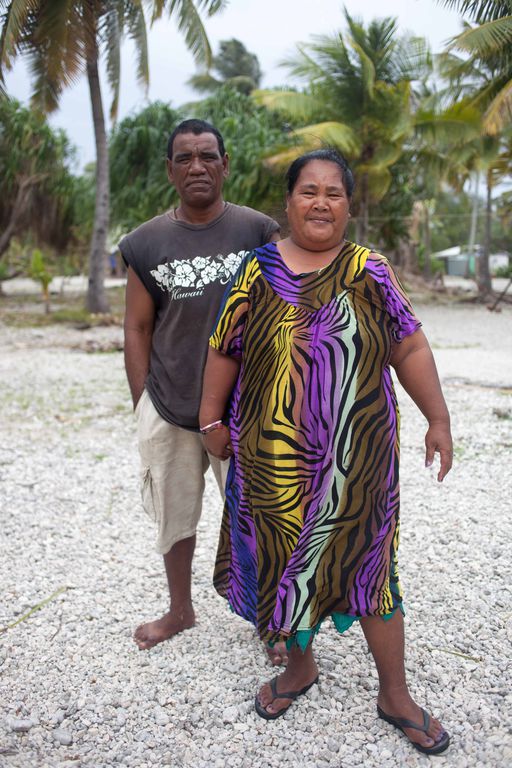
Hemy and Rosemary Anitok usually dig for copper on Runit Island for a month. They sell it for $1 per pound. In December 2013, they collected more than 2,600 pounds.
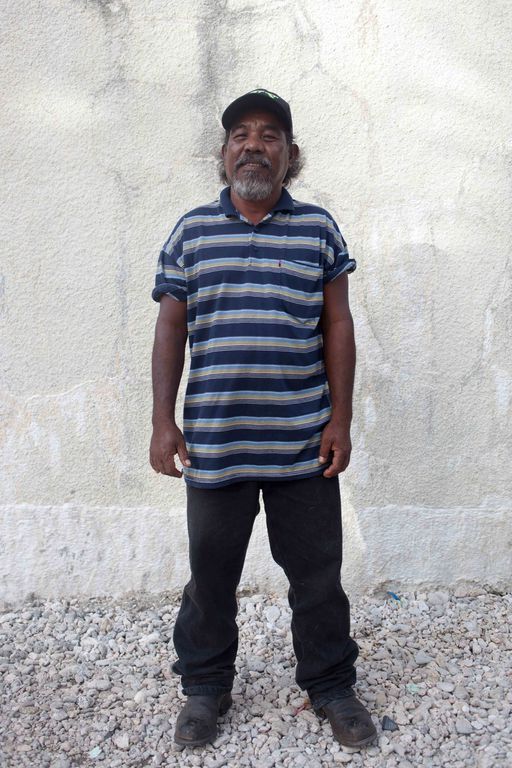
Maita Ken, a copper digger and agricultural worker, says when there’s a drought, “I bathe in the ocean because there’s no water.”Though Buesseler and his team only tested soil that’s underwater, he’s still concerned about people digging in contaminated grounds on the islands: “For people digging for copper there, that’s exactly what you don’t want to do is inhale dust with plutonium. I certainly would not want to be digging around.”
The DOE’s contracted scientist, Hamilton, who visits the atoll regularly, reassures the local population that Enewetak’s plutonium levels are normal; that living with a leaking nuclear waste site in your backyard doesn’t pose any health risks. Yet, the DOE, according to local employees, keeps separate lists of those they know dig for copper.
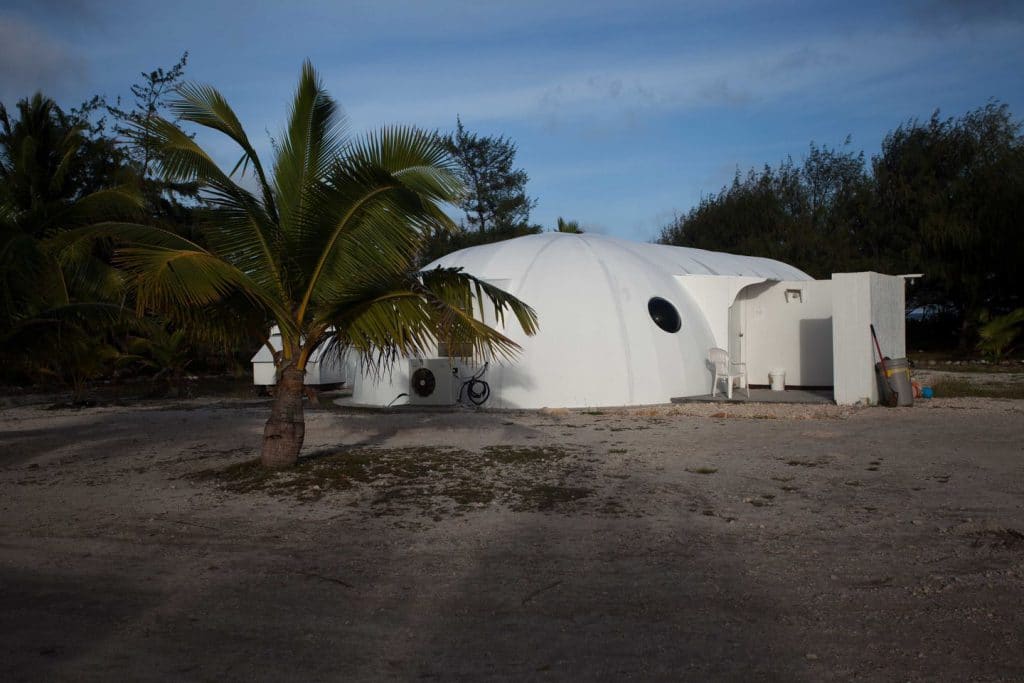
The U.S. Department of Energy’s laboratory in Enewetak includes a full-body counter to detect levels of cesium.
Brooke doesn’t trust the scientists, whether independent or government contracted.
“I often wonder why nobody knows about Enewetak,” she says. “Is it just because it’s so remote that the United States did such a good job of keeping things quiet here?”
THE BIG SCRAPE
Enewetak’s trees are dwarfed. Every palm or breadfruit tree is younger than 38 years old: The trees that survived the bombings were cut down in the Big Scrape, the three-year cleanup process that started in 1977 and culminated in the construction of the Dome. When the Americans finished, they gave the islanders a tour of the lingering debris, Takaji remembers, asking if they still wanted to return or settle on new, clean land in Hawaii. The islanders voted to stay.
The soil scrape — which may or may not have removed lingering radionuclides — also removed whatever nutrients were present in the sparse, high-calcium coral soil. Some places were left with only inches of black, fertile top-soil above the bedrock. Today, 37 of Enewetak’s 40 islands are technically no-go zones. “People would go to one island to collect eggs, to another, to catch crabs or get fruit,” Takaji says. It was a self-sustaining system, utilizing the whole atoll. Not anymore.
“The soil is so damaged that you can’t plant anything,” says Takaji. “I don’t know what the Americans can do to change that.”
To counter the effect of the lost food sources on the contaminated islands, the local government bought the Lady E. But the fragile ship now only comes three times a year instead of four, always with delays. When it finally breaks the months-long spell of isolation, the food is unloaded first.
In a corrugated shed, islanders queue patiently for their rations under a single light bulb swinging from the ceiling. Having subsisted on coconut, flour, and the occasional fish for weeks, children have swollen bellies and adults have chapped lips and rashes. Nowadays, the USDA-funded Supplemental Food Program makes up the bulk of Enewetak’s diet: canned tuna and mackerel replaces fresh caught reef fish, white rice instead of breadfruit. At the island’s small clinic, diabetes prevention posters discourage islanders from eating any of it, proposing local fruits and vegetables instead. The diet advice seems like a cruel joke.
It wasn’t always like this.
Mores, one of the first to be born on the island after the Big Scrape, grew up on an island awash in cash. He knew of his nearby but still-contaminated ancestral land from elders’ stories. The compensation money for the nuclear testing was intoxicating to inhabitants of an island so recently introduced to currency. Everyone had a car, racing up and down the airstrip. Many opened shops and food joints. As a child, Mores won $2,000 playing billiards at his sister’s restaurant. No one saved.
The wealth is long gone. All but one of Mores’ sisters moved to Hawaii’s Big Island, where almost all Enewetakese end up, seeking jobs on macadamia and coffee plantations. Last year, Mores’ mother died from cancer that was detected too late for treatment. Mores has no idea how long he and his family will stay. Around him, almost everyone who can afford to leave is long gone. From his own family, his sister Rosie, Milan’s mother, is the only one left.
Enewetak is officially broke, dividing its trust fund from U.S. reparations across an ever-larger number of people, including those who live elsewhere. Quarterly payout checks are down to $98 for Mores and the children. Every quarterly food ration is smaller and less nutritious than the last. When Brooke first lived here they got canned juice, vegetables, and live chickens. Her last parcel contained one and a half bags of rice, half a bag of flour, three cans of corned beef, three cans of Spam, one can of mackerel, two cans of tuna, one bottle of soy sauce, three cans of pineapples, three cans of peaches, one case of condensed milk, and two boxes of sugar cereal. It runs out quicker than anticipated. In 2023, the supplemental food program will end altogether.
EVERYTHING WILL BE EMPTY
A week after returning to Enewetak with Brooke and Mores, Milan prepares to board the Lady E again. Along with her parents, she’ll take the trip back to Majuro and then move onwards to Hawaii. Like many other Enewetakese, Milan’s parents have decided to try their luck elsewhere.
The sun sets over the lagoon, as Milan, with some 150 other passengers, coolers, firewood (one rice bag of firewood sells for $20 in crowded Majuro) and coconuts for the journey, is loaded onto the ship. The copper is on it too, traveling on to Fujian, China.
The Lady E was never meant to transport people, but in summer, its peak season, she carries up to 450 passengers — well above capacity — toward Majuro and beyond. The frustration of living in a place where the Marshallese lifestyle has become impossible is triggering a mass exodus.
“One day that boat will come and there will be like 50 of us left,” says Mores. “There’ll be nobody left here, no one in any of these houses.”
He points to the buildings around him: Everyone he grew up with is already gone.
“They’ll all lock everything up and go. Everything will be empty.”
EPILOGUE
Brooke and her family left Enewetak about a year after she moved back there to continue working on her PhD in Majuro. Because of a drought, she couldn’t return, as the atoll ran out of water. After nine months in the Marshall Islands’ capital, she, her husband, and her sons, now nearly 5 and 9 years old, temporarily moved to Fiji, where she worked on her PhD.
Mores briefly went back to Enewetak earlier this year to host a group of Japanese scientists and doctors from Gensuikyo (the Japan Council on A & H Bombs). He also spoke in August 2017 at the Gensuikyo World Conference Against A & H Bombs in Hiroshima and Nagasaki.
Brooke and Mores plan to return to Enewetak yet again this spring. So does Milan, who currently lives in Hawaii.
Takaji Iso still lives in Enewetak.

